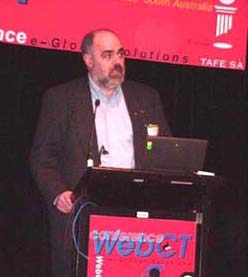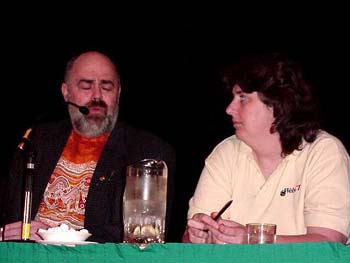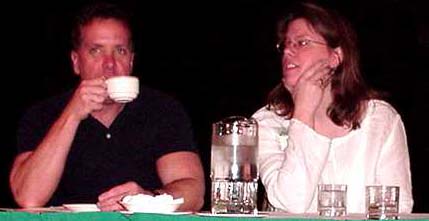The WebCT Asia Pacific Conference
Adelaide, Australia (March 22-24)
| The WebCT Asia Pacific conference took place in Adelaide last week. Participants and presenters came from all over Australia, with a sprinkling of persons from New Zealand, Japan, Singapore, and one person from South Africa. There was also a large contingent of people from WebCT itself, principal among them the creator of WebCT, Murray Goldberg. |
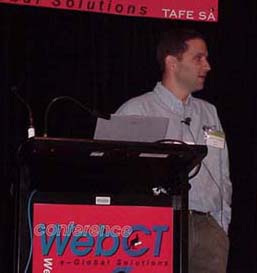 |
While many of the presentations had WebCT as their focus, many presentations had online teaching and learning in general as their theme, and as such there was plenty of useful input for someone who had little or no experience of WebCT.
 |
The conference was kicked off with an entertaining address from Ron Oliver from Edith Cowan University in WA. Ron is well known internationally in online circles and is a sometime colleague of Professor Tom Reeves from the University of Georgia, who many Australians know from his visit here in 1999. Ron focused on the web as a teaching tool, and stressed that "great tools do not a great teacher make." Contrary to what many believe - that online learners are condemned by the medium to isolation - he argued that the Internet supplies a ready made vehicle for collaborative learning. Tools like WebCT however need to be in the hands of skilled facilitators to enable students to get the most out of them. |
It was refreshing to learn that Ron is still very much involved in teaching, as is Murray Goldberg. Many conference participants were surprised to learn that people like Ron and Murray, despite their research responsibilties and international profile, are still teaching and clearly have a passion for it.
| Greg Jarboe, vice president of WebCT marketing, remarked in his closing address that the WebCT team had been very pleasantly surprised at what people in this region were doing with WebCT, and at the fact that several institutions in the R-12 sector (schools) were using WebCT. Steve Smith from Tasmania illustrated a case in point. Steve teaches primary school music and embeds music files into his WebCT delivered instructional materials to aid students listening. In another presentation Shoji Kajita from Nagoya University demonstrated state of the art MPEG video operating within WebCT, and his talk on internationalising WebCT for use in Japan was further evidence of the spread of this product around the planet. |
|
| Several WebCT staff presented at the conference. Glen Low, Director of Educational Technology and Development, refreshingly focused more on the pedagogy of online learning rather than the technology per se. He referred to various aspects of online education such as fading (where the teacher slowly recedes into the background as the student comes more to the fore) and cognitive apprenticeship - what we may know better as shadowing an expert. Something else gleaned from Glen Low's two presentations is the fact that so many of the problems instructors can have with WebCT are the result of web technology itself, not WebCT software. |
|
Peter Higgs from Tasmania spoke on the LearnScope project undertaken in Tasmania last year which took a top down approach. Top down in as much that the project participants were managers. The success of this project was such that now it is managers who are hassling Peter and colleagues to get more material online! He also told of a network of online access centres across the state which are licensed to offer online materials and offer on site support for learners - a model that other states might well consider adopting.
|
|
Murray Goldberg's address was undoubtedly a highlight. Though Murray himself didn't say it, it is easy to see his passion for teaching and learning. It is indeed a remarkable story that he and colleague Sasan Salari embarked on the task of creating an effective delivery tool to make life easier for their students, and almost by accident the resulting product, WebCT, spread across the globe with zero marketing! Most of Murray's engaging talk focused on research he had undertaken to test the effectiveness of online learning. The conclusions of his research are clear: a combination of face to face and online delivery is the best of both worlds for students and produces the best results. In his research students who had access to both forms of delivery outperformed students who had access to only one or the other mode of teaching. What became clear too was the student management and tracking features of WebCT provide instant data for research purposes. |
Peter Love from Macquarie University talked about what drove academic staff at Macquarie to turn to online learning. Lack of sufficient computer labs, a desire to standardize resources within departments were two compelling factors in the move to online learning at Macquarie. They found further that as both staff and students learnt of the successes of early adopters, the spill over effect to others has created its own momentum and demand for further online offerings. Another factor in operation too was the superb nature of many resources on the web (something Ron Oliver also referred to) such as interactive simulations. Other interesting hallmarks of the Macquarie program are the deal with the London School of Economics to provide round the clock student/helpdesk support, and their strategy of placing the student feedback instrument on the welcome page of modules to increase the number of student responses.
An interesting strategy used by Parviz Doulai of Wollongong University to induce a professional development program for staff was simply to publicise data relating to existing online courses at the university. This data is produced automatically by WebCT's student tracking features. Focusing particularly on the bulletin board features, this data is compelling evidence of the amount of student- to-student and staff-to-student online communication. Together with this information went an invitation to staff to contact Parviz if they were interested in any professional development in online teaching . He received 30 replies in the first day. Thus began Wollongong University's professional development program in online teaching!
Linda Selby from the Auckland College of Education in New Zealand discussed how technology of the past has failed to live up to its expectations, and posed the question as to whether the web would be any different. (TV was hailed as a threat to teachers; why don't we have telephones in classrooms?) Her institution chose WebCT because they believed it didn't require a high level of expertise and you can select or reject from its range of available tools. Their professional development project used the buddy system where teachers pair up with students in school and results of the program showed an increase in problem solving skills from students.
| Greg Jarboe's keynote address on the final morning detailed the phenomenal rise of WebCT, and shared the company’s vision of the future. Despite the frequently cited lack of take up of online education, he showed data that indicates that teaching staff worldwide are steadily increasing their uptake of technology, in the use of email and web resources. |
|
Other data on display showed that the profile of the average university student in the US is changing - the student body is getting older, and only 40% of them buy new text books. Enter book publishers into the online arena. WebCT now has deals with several book publishers who provide ready made 'courselets' based on their textbooks. This echoed a theme across the conference that it is not necessary to have complete pre-packaged content on the web before you can run an online course. Neil Strong (SA TAFE) referred to it as 'contentless teaching'. The material already exists out there on the web runs the argument. You just need your students to have access to it, get them to analyse it, and provide the tools for online interaction.
Other trends emerging from the conference referred to by Stephen Fisher (Northpoint TAFE, QLD), and Neil Strong on the final day were:
|
|
|
|
Conclusion WebCT has copped its fair share of criticism. However what seems to be evident from this conference is that WebCT has evolved out of a desire by its creators to improve learning for students, and not from any overt profit motive. Some of its technological deficiencies are the fault of web technology, not the software itself. While many have considered its design inelegant and non-instinctive for developers, conference demonstrations of the new version 3.0 to be released in July show an entirely different, more user friendly interface, and more attractive product. |
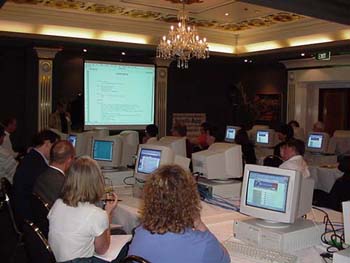 |
WebCT is now used in approximately 1400 institutions in 55 countries across the globe, and in the Asia Pacific region alone many have already produced impressive resources using it as their delivery platform, and have plotted their online future with WebCT in mind. And from what I've seen over the last few days, I'd say that is a wise decision.
|
|
|
Michael Coghlan (24/3/00) |
|
|
